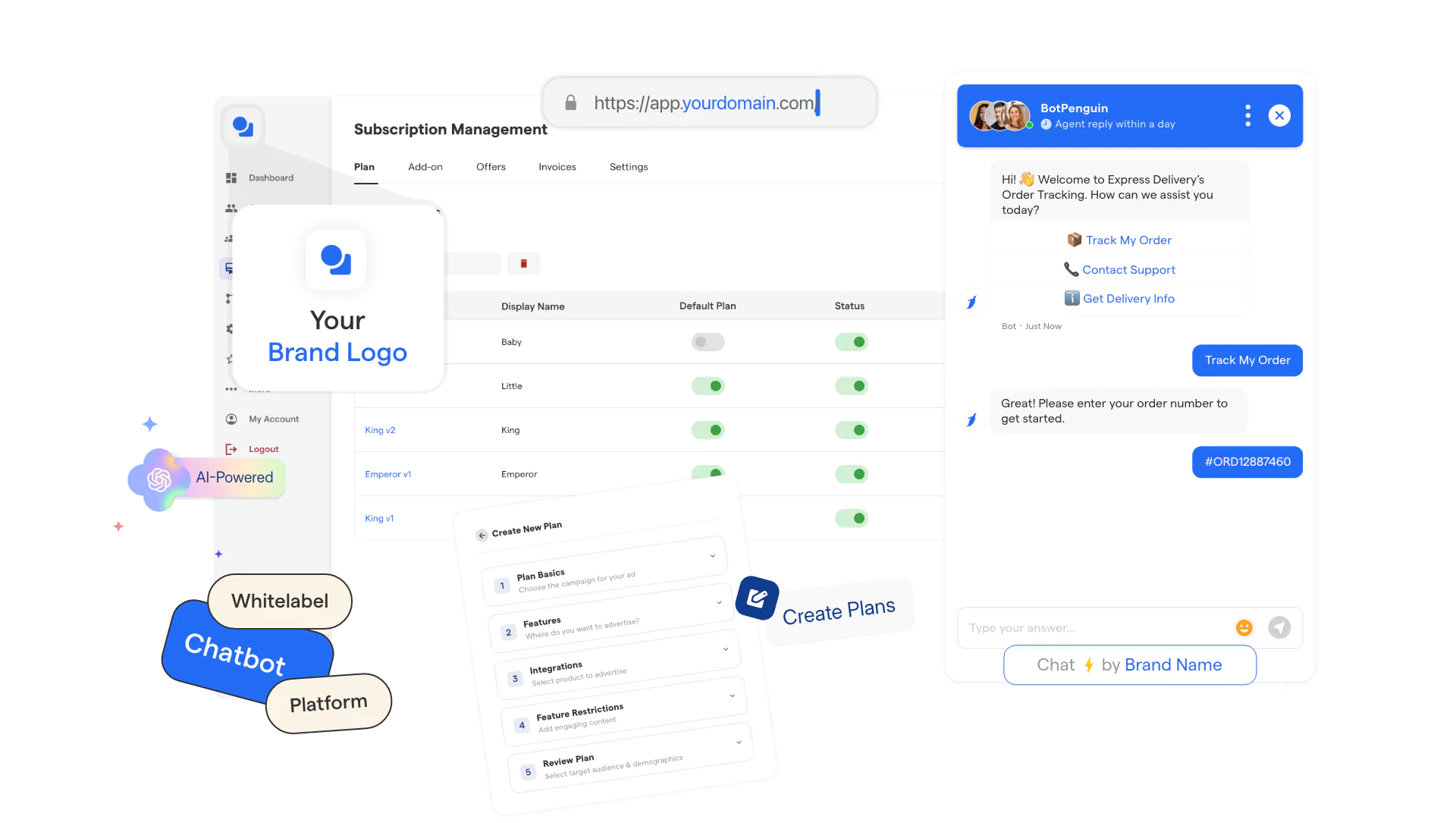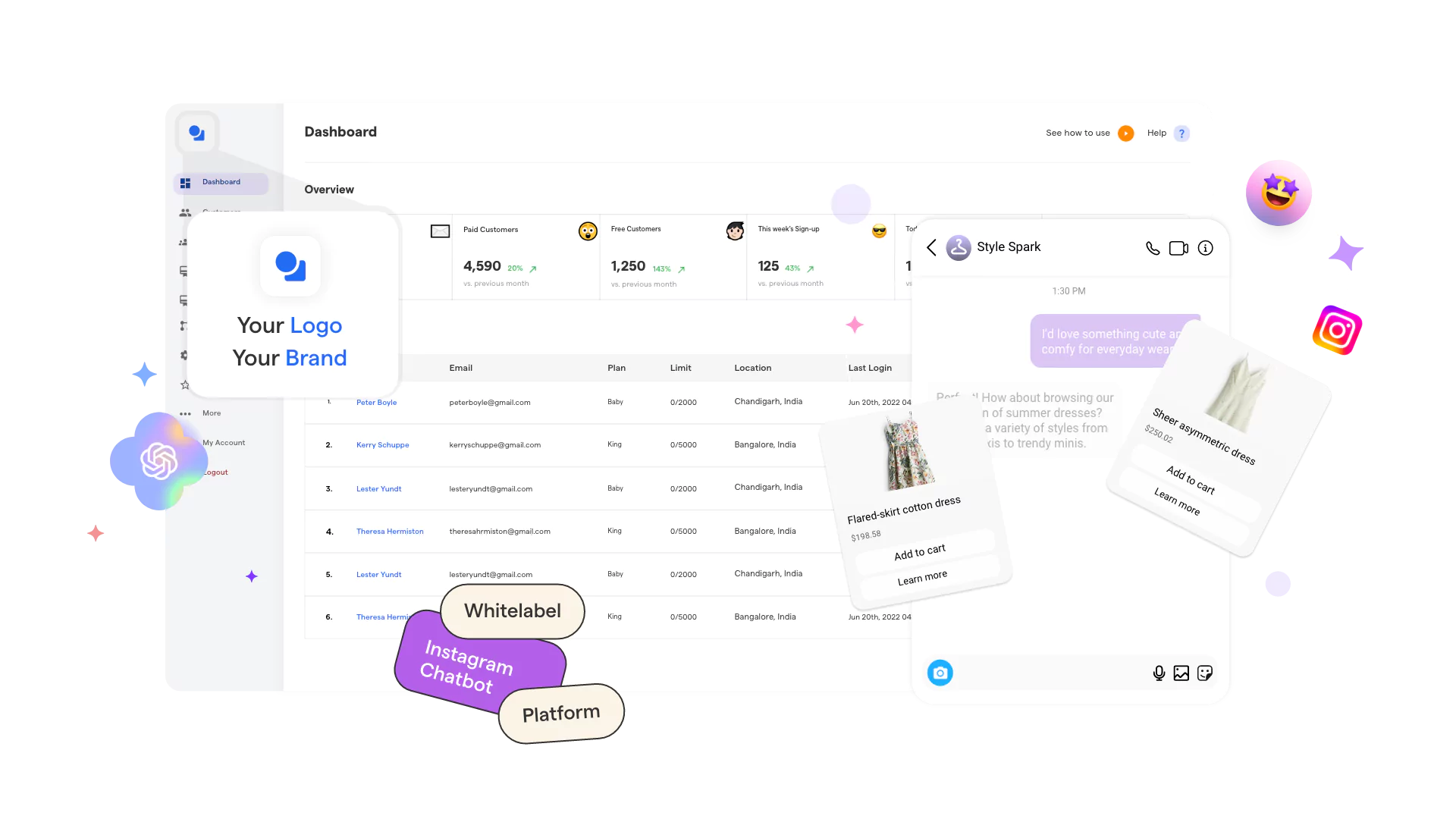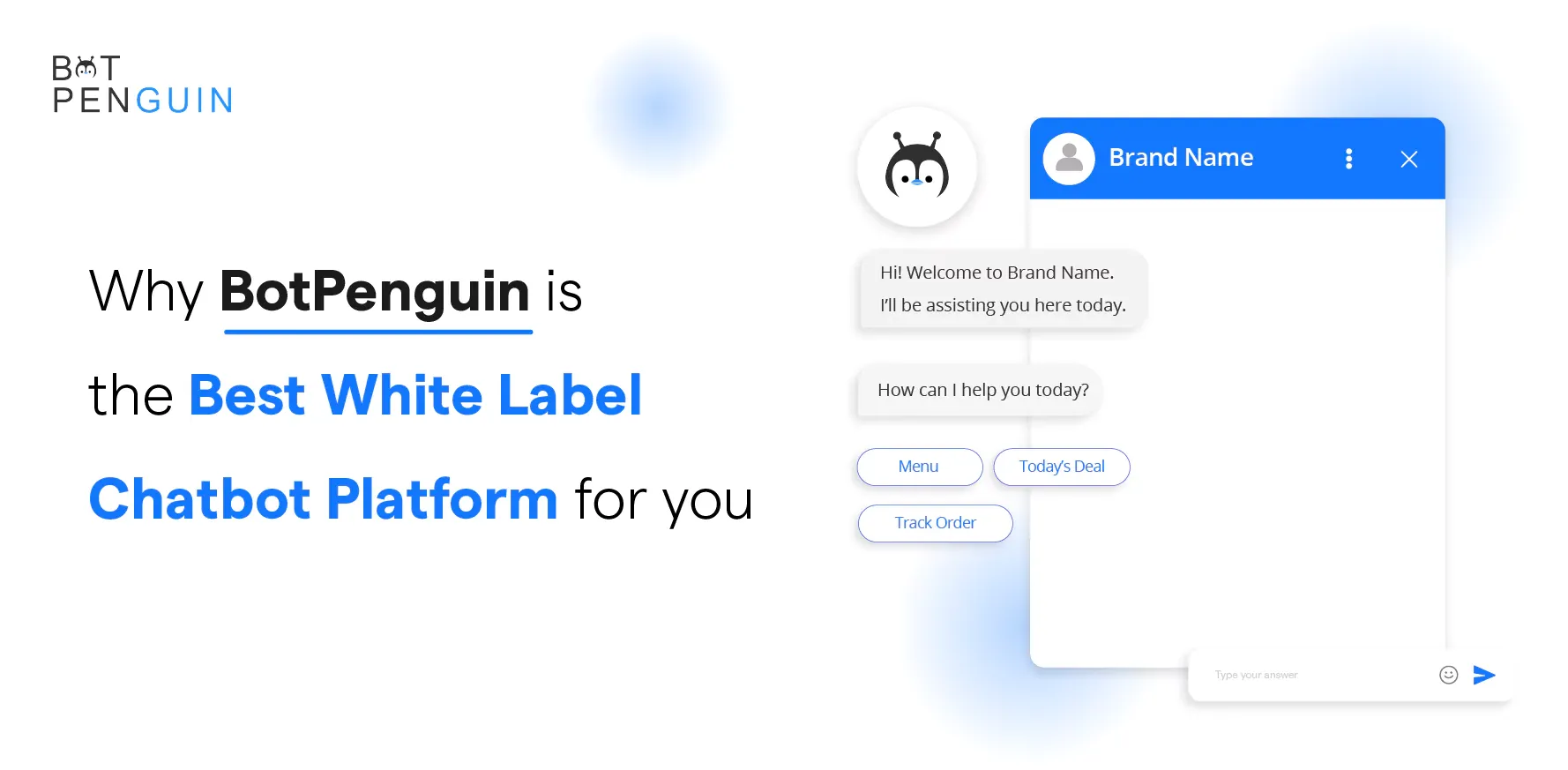Introduction
ManyChat doesn’t have a white label.
That surprises a lot of people. The platform looks powerful, flexible, and perfect for handing over to clients or team members.
But the moment you try to give someone else access under your own brand, you hit a wall. You can’t rebrand the dashboard. You can’t hide the ManyChat name.
This matters if you want others to manage chats while you stay in control. In this guide, we’ll break down why that’s the case, what partial fixes you can use, and the best alternatives if you need full branding and user access without the extra hassle.
Limitations of ManyChat When It Comes to White Labeling
If your goal is to deliver a service under your own brand, every part of the experience matters — including the tools your users touch. It’s not just about looks.
A consistent brand builds trust, reinforces value, and makes your solution feel like a complete package.
That’s why it’s frustrating when the platform you rely on can’t hide its own name. ManyChat is powerful, but it’s not built to vanish into the background while your brand takes center stage.
If you want your clients or team members to feel like they’re using your platform, here’s where you’ll run into roadblocks.
Can’t Give a Branded Live Chat Dashboard
Live Chat is one of ManyChat’s best features for real-time communication. But the moment you hand it over, your brand disappears. The dashboard lives inside ManyChat’s own interface. The domain, colors, and navigation all belong to them.
For someone offering a branded solution, this is more than a cosmetic issue. It changes how your users perceive you.
Instead of thinking “I’m using [Your Company’s] platform,” they know they’re inside ManyChat. That dilutes your brand value and makes it harder to present your service as a complete, standalone product.
Needing to Create Multiple Accounts
When you serve multiple clients or user groups, you need separation. But with ManyChat, there’s no central admin control to manage all groups from one branded space. The only option is to create a separate account for each.
That means juggling multiple logins, switching accounts constantly, and losing any sense of unified oversight. For a branded provider, it also means you can’t promise a seamless, all-in-one experience — your users still see the seams.
Managing Credentials in a Spreadsheet
A common workaround is to set up a ManyChat account for your user, build everything, and hand over the login. It works — but it leaves you with a growing list of usernames and passwords stored in a spreadsheet.
From a branding perspective, it’s not a great look. From a security perspective, it’s even worse. And as your business scales, managing credentials this way becomes a risk you can’t ignore.
These limitations aren’t just quirks of the platform — they’re barriers to delivering a fully branded, professional solution.
If you’re determined to keep ManyChat in your stack, you’ll need creative ways to work around these gaps while keeping your brand front and center. The next section explores how.
Workarounds If You Still Want to Use ManyChat White Label
If you’re set on using ManyChat but still want to present it as your own branded solution, you’ll need to get creative.
The platform wasn’t designed to disappear behind your brand, but there are ways to soften its presence.
These workarounds won’t give you a true ManyChat white label setup, but they can help you deliver a more branded experience to your clients, partners, or teams.
The key is to think about every touchpoint your users see — from the interface to the training materials — and replace as much of ManyChat’s identity with your own as possible.
Remove branding where possible
If you’re on a paid ManyChat plan, you can remove their logos from certain customer-facing widgets. This includes some opt-in forms, landing pages, and growth tools.
For a branded solution provider, even small changes like this matter. A form without ManyChat’s name keeps the focus on your business. It’s not a full rebrand, but it helps create a cleaner, more consistent user experience.
Create an account on their behalf
Another option is to set up a ManyChat account in your user’s name. You handle all the technical setup — building flows, connecting channels, and configuring automations — before handing over the login credentials.
This lets your user control chats and campaigns as if it’s “their” platform. You can still keep admin access, which means you can update or fix things without them seeing the backend work.
The trade-off? You’re still tied to ManyChat’s interface and branding. And managing multiple accounts like this can get messy fast.
Use branded resources externally
If you can’t rebrand the dashboard, you can control everything around it. Give your users onboarding videos, step-by-step guides, and branded URLs that frame the ManyChat experience as part of your own product.
For example, you might send them to a resource hub on your domain that links to ManyChat tools. The interface inside will still be theirs, but the journey starts and ends with your brand.
These workarounds won’t fully solve the white label challenge, but they can bridge the gap if you’re not ready to switch platforms.
Still, if your goal is complete brand control and a streamlined way to onboard and manage users, you’ll need a different solution. That’s where alternatives come in.
The Best Alternatives to ManyChat White Label
If full brand control and smooth user management are critical to your service, you’ll quickly hit ManyChat’s limits. Partial fixes help, but they can’t replace a platform designed for white labeling from the ground up.
That’s where alternatives come in — tools built to let your brand take center stage while still giving you the features you need to deliver value.
Among these, BotPenguin stands out for combining familiar functionality with a complete reselling ecosystem.
You get the tools your users expect and the controls you need to operate under your own brand without compromises.
BotPenguin — White Label With Complete Reselling Ecosystem

BotPenguin offers everything you’d expect from a platform like ManyChat — and then some. The visual builder is easy to use, and the automation is flexible.
You can run multichannel campaigns, including omnichannel chat, on platforms like Instagram, WhatsApp, Website, Shopify, Live Chat, and ManyChat’s prime feature, such as comment-to-DM automation.
Where it pulls ahead is in the way it hands the platform over to your brand:
- Onboard users via your own signup page — no third-party branding at the entry point.
- Custom domain, logo, and colors across the entire interface.
- A branded dashboard where your users manage chats and automations without seeing BotPenguin’s name.
- Partner Panel for complete control over accounts, subscriptions, and services: Manage everything in one dashboard, Create subscription plans with add-ons, Sell value-added services alongside your core offer, Set prices in any currency, Use payment gateways that your clients already trust, Full ownership of customer data, Add unlimited customers with no extra per-user cost, Create unlimited AI Agents without per-agent pricing.
- Marketing kit and help docs you can fully rebrand.
- White label integrations for Shopify and WordPress.
- White label mobile app for on-the-go access.
- White label API/Webhooks to embed BotPenguin into your existing tools.
Support Provided by BotPenguin for White Label Partners
Running your own branded platform means you need strong support. BotPenguin provides:
- Instant panel setup to get you operational fast.
- Hands-on training so you master the product quickly.
- Multiple support channels — email, call, WhatsApp.
- Help center for answers anytime.
- Dedicated partner support officer for priority assistance.
- Instant feature updates so your platform is always ahead.
Comparing ManyChat’s White Label Capabilities with BotPenguin’s White Label Program
Getting Started With BotPenguin White Label
Getting your own branded platform with BotPenguin is simple, and the process is built to get you earning fast — without paying for idle time. Here’s how it works:
Step 1: Fill the form. This starts your request for the white label program.
Step 2: Our team will reach out and give you a live demo of the white label setup, so you can see exactly how it works for you and your clients.
Step 3: Choose the plan that fits your goals and make the payment.
Step 4: We’ll set up your branded dashboard — complete with your logo, domain, and colors.
Step 5: Start onboarding clients. You can begin earning immediately, and if you haven’t onboarded a customer in the first 30 days, we won’t start your subscription yet.
Step 6: While that’s happening, explore the included platform pages for our white label programs.
(These vary by channel, but your plan covers all omnichannel platforms and their features. You pay once and later tailor your offering to match your services.)
- https://botpenguin.com/partners/white-label-instagram-chatbot
- https://botpenguin.com/partners/white-label-whatsapp-chatbot
- https://botpenguin.com/partners/white-label-chatbot
- https://botpenguin.com/white-label-chatbot-pricing
With these steps, you get a ready-to-sell platform that looks like it’s entirely yours — plus the tools and flexibility to shape it for any market you serve.
Conclusion
ManyChat is a solid platform, but it doesn’t offer a full white label solution. If your goal is to provide a service under your own brand, the built-in limitations — from dashboard branding to account management — make that difficult.
Workarounds can help, but they’re just patches. They don’t give you the control, consistency, or professional polish that comes from having a platform truly branded as your own.
BotPenguin removes those barriers. It gives you complete brand ownership, a streamlined way to onboard and manage users, and all the tools needed to scale without losing control of the experience.
For anyone serious about delivering their own branded solution, it’s the cleaner and more scalable choice.
Frequently Asked Questions (FAQs)
Is it legal to resell a ManyChat white label alternative under my own brand?
Yes. A true white label alternative is built for reselling. You can use your branding, set your pricing, and control the customer experience without violating the platform’s terms.
What is the best alternative to ManyChat for full white label branding?
Platforms like BotPenguin offer full branding control — logo, domain, colors — plus a branded dashboard and reseller tools. These features aren’t available in ManyChat, making such platforms better for those needing a complete white label experience.
Can I migrate my flows from ManyChat to a white label alternative?
In most cases, yes. While chat histories may not always transfer, you can export subscriber data and recreate automation flows in your new platform using similar logic and triggers.
Are white label alternatives to ManyChat more expensive?
Not always. Some have comparable or even lower costs than ManyChat, especially when factoring in the extra time, tools, and resources needed to maintain workarounds in ManyChat.
Do alternatives to ManyChat offer built-in reseller features?
Yes. Many white label platforms include partner panels for creating subscription plans, managing clients, and billing — something ManyChat doesn’t offer natively.



